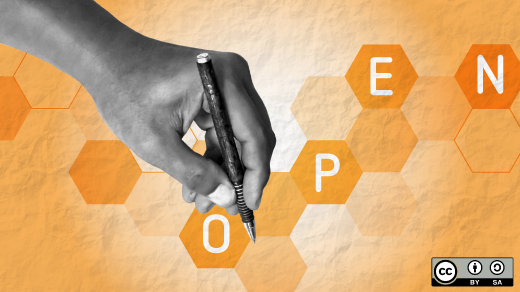GNOME, Java, Jupyter, Python. If your friends or family members have ever eavesdropped on your work conversations, they might think you've made a career in Renaissance folklore, coffee roasting, astronomy, or zoology. Where did the names of these open source technologies come from? We asked our writer community for input and rounded up some of our favorite tech name origin stories.
Ansible
The name "Ansible" is lifted directly from science fiction. Ursula Le Guin's book Rocannon's World had devices allowing instantaneous (faster than light) communication called ansibles (derived, apparently, from the word "answerable"). Ansibles became a staple of science fiction, including in Orson Scott Card's Ender's Game (which later became a popular film), where the device controlled many remote space ships. This seemed to be a good model for software that controls distributed machines, so Michael DeHaan (creator and founder of Ansible) borrowed the name.
Apache
Apache is an open source web server that was originally released in 1995. Its name is not related to the famous Native American tribe; it instead refers to the repeated patches to its original software code. Hence, "A-patchy server."
awk
"awk(1) Stands for Aho, Weinberger, Kernighan (authors)" —Michael Greenberg
Bash
"The original Unix shell, the Bourne shell, was named after its creator. At the time Bash was being developed, csh (pronounced 'seashell') was actually more popular for interactive user logins. The Bash project aimed to give new life to the Bourne shell by making it more suitable for interactive use, thus it was named the 'Bourne again shell,' a pun on 'born again.'" —Ken Gaillot
C
"In early days, Ken Thompson and Dennis Ritchie at AT&T found it interesting that you could use a higher-level programming language (instead of low-level and less-portable assembly programming) to write operating systems and tools. There was an early programming system called BCPL (Basic Combined Programming Language), and Thompson created a stripped-down version of BCPL called B. But B wasn't very flexible or fast. Ritchie then took the ideas of B and expanded it into a compiled language called C." —Jim Hall
dd
"I don't think you can publish such an article without mentioning dd. My nickname is Didi. Correctly pronounced, it sounds like 'dd.' I first learned Unix, and then Linux, in 1993 as a student. Then I went to the army, arrived to one of the very few sections in my unit that used Unix (Ultrix) (the rest were mainly VMS), and one of the people there said: 'So, you are a hacker, right? You think you know Unix? OK, so what's the reason for the name dd?' I had no idea and tried to guess: "Data duplicator?" So he said, 'I'll tell you the story of dd. dd is short for convert and copy (as anyone can still see today on the manpage), but since cc was already taken by the c compiler, it was named dd.' Only years later, I heard the true story about JCL's data definition and the non-uniform, semi-joking syntax for the Unix dd command somewhat being based on it." —Yedidyah Bar David
Emacs
The classic anti-vi editor, the true etymology of the name is unremarkable, in that it derives from "Editing MACroS." Being an object of great religious opprobrium and worship it has, however, attracted many spoof bacronyms such as "Escape Meta Alt Control Shift" (to spoof its heavy reliance on keystrokes), "Eight Megabytes And Constantly Swapping" (from when that was a lot of memory), "Eventually malloc()s All Computer Storage," and "EMACS Makes A Computer Slow." —Adapted from the Jargon File/Hacker's Dictionary
Enarx
Enarx is a new project in the confidential computing space. One of the project's design principles was that it should be "fungible." so an initial name was "psilocybin" (the famed magic mushroom). The general feeling was that manager types would probably be resistant, so new names were considered. The project's two founders, Mike Bursell and Nathaniel McCallum, are both ancient language geeks, so they considered lots of different ideas, including тайна (Tayna—Russian for secret or mystery—although Russian, admittedly, is not ancient, but hey), crypticon (total bastardization of Greek), cryptidion (Greek for small secret place), arcanus (Latin masculine adjective for secret), arcanum (Latin neuter adjective for secret), and ærn (Anglo-Saxon for place, secret place, closet, habitation, house, or cottage). In the end, for various reasons, including the availability of domains and GitHub project names, they settled on enarx, a combination of two Latin roots: en- (meaning within) and -arx (meaning citadel, stronghold, or fortress).
GIMP
Where would we be without GIMP? The GNU Image Manipulation Project has been an open source staple for many years. Wikipedia states, "In 1995, Spencer Kimball and Peter Mattis began developing GIMP as a semester-long project at the University of California, Berkeley, for the eXperimental Computing Facility."
GNOME
Have you ever wondered why GNOME is called GNOME? According to Wikipedia, GNOME was originally an acronym that represented the "GNU Network Object Model Environment." Now that name no longer represents the project and has been dropped, but the name has stayed. GNOME 3 is the default desktop environment for Fedora, Red Hat Enterprise, Ubuntu, Debian, SUSE Linux Enterprise, and more.
Java
Can you imagine this programming language being named anything else? Java was originally called Oak, but alas, the legal team at Sun Microsystems vetoed that name due to its existing trademark. So it was back to the drawing board for the development team. Legend has it that a massive brainstorm was held by the language's working group in January 1995. Lots of other names were tossed around including Silk, DNA, WebDancer, and so on. The team did not want the new name to have anything to do with the overused terms, "web" or "net." Instead, they were searching for something more dynamic, fun, and easy to remember. Java met the requirements and miraculously, the team agreed!
Jupyter
Many of today's data scientists and students use Jupyter notebooks in their work. The name Jupyter is an amalgamation of three open source computer languages that are used in the notebooks and prominent in data science: Julia, Python, and R.
Kubernetes
Kubernetes is derived from the Greek word for helmsman. This etymology was corroborated in a 2015 Hacker News response by a Kubernetes project founder, Craig McLuckie. Wanting to stick with the nautical theme, he explained that the technology drives containers, much like a helmsman or pilot drives a container ship. Thus, Kubernetes was the chosen name. Many of us are still trying to get the pronunciation right (koo-bur-NET-eez), so K8s is an acceptable substitute. Interestingly, it shares its etymology with the English word "governor," so has that in common with the mechanical negative-feedback device on steam engines.
KDE
What about the K desktop? KDE originally represented the "Kool Desktop Environment." It was founded in 1996 by Matthias Ettrich. According to Wikipedia, the name was a play on the words Common Desktop Environment (CDE) on Unix.
Linux
Linux was named for its inventor, Linus Torvalds. Linus originally wanted to name his creation "Freax" as he thought that naming the creation after himself was too egotistical. According to Wikipedia, "Ari Lemmke, Torvalds' coworker at the Helsinki University of Technology, who was one of the volunteer administrators for the FTP server at the time, did not think that 'Freax' was a good name. So, he named the project 'Linux' on the server without consulting Torvalds."
Following are some of the most popular Linux distributions.
CentOS
CentOS is an acronym for Community Enterprise Operating System. It contains the upstream packages from Red Hat Enterprise Linux.
Debian
Debian Linux, founded in September 1993, is a portmanteau of its founder, Ian Murdock, and his then-girlfriend Debra Lynn.
RHEL
Red Hat Linux got its name from its founder Marc Ewing, who wore a red Cornell University fedora given to him by his grandfather. Red Hat was founded on March 26, 1993. Fedora Linux began as a volunteer project to provide extra software for the Red Hat distribution and got its name from Red Hat's "Shadowman" logo.
Ubuntu
Ubuntu aims to share open source widely and is named after the African philosophy of ubuntu, which can be translated as "humanity to others" or "I am what I am because of who we all are."
Moodle
The open source learning platform Moodle is an acronym for "modular object-oriented dynamic learning environment." Moodle continues to be a leading platform for e-learning. There are nearly 104,000 registered Moodle sites worldwide.
Two other popular open source content management systems are Drupal and Joomla. Drupal's name comes from the Dutch word for "druppel" which means "drop." Joomla is an anglicized spelling of the Swahili word "jumla," which means "all together" in Arabic, Urdu, and other languages, according to Wikipedia.
Mozilla
Mozilla is an open source software community founded in 1998. According to its website, "The Mozilla project was created in 1998 with the release of the Netscape browser suite source code. It was intended to harness the creative power of thousands of programmers on the internet and fuel unprecedented levels of innovation in the browser market." The name was a portmanteau of Mosaic and Godzilla.
Nginx
"Many tech people try to be cool and say it 'n' 'g' 'n' 'x'. Few actually did the basic actions of researching a bit more to find out very quickly that the name is actually supposed to be said as 'EngineX,' in reference to the powerful web server, like an engine." —Jean Sebastien Tougne
Perl
Perl's founder Larry Wall originally named his project "Pearl." According to Wikipedia, Wall wanted to give the language a short name with positive connotations. Wall discovered the existing PEARL programming language before Perl's official release and changed the spelling of the name.
Piet and Mondrian
"There are two programming language named after the artist Piet Mondrian. One is called 'Piet' and the other 'Mondrian.' [David Morgan-Mar writes]: 'Piet is a programming language in which programs look like abstract paintings. The language is named after Piet Mondrian, who pioneered the field of geometric abstract art. I would have liked to call the language Mondrian, but someone beat me to it with a rather mundane-looking scripting language. Oh well, we can't all be esoteric language writers, I suppose.'" —Yuval Lifshitz
Python
The Python programming language received its unique name from its creator, Guido Van Rossum, who was a fan of the comedy group Monty Python.
Raspberry Pi
Known for its tiny-but-mighty capabilities and wallet-friendly price tag, the Raspberry Pi is a favorite in the open source community. But where did its endearing (and yummy) name come from? In the '70s and '80s, it was a popular trend to name computers after fruit. Apple, Tangerine, Apricot... anyone getting hungry? According to a 2012 interview with founder Eben Upton, the name "Raspberry Pi" is a nod to that trend. Raspberries are also tiny in size, yet mighty in flavor. The "Pi" in the name alludes to the fact that, originally, the computer could only run Python.
Samba
Server Message Block for sharing Windows files on Linux.
ScummVM
ScummVM (Script Creation Utility for Maniac Mansion Virtual Machine) is a program that makes it possible to run some classic computer adventure games on a modern computer. Originally, it was designed to play LucasArts adventure games that were built using SCUMM, which was originally used to develop Maniac Mansion before being used to develop most of LucasArts's other adventure games. Currently, ScummVM supports a large number of game engines, including Sierra Online's AGI and SCI, but still retains the name ScummVM. A related project, ResidualVM, got its name because it covers the "residual" LucasArts adventure games not covered by ScummVM. The LucasArts games covered by ResidualVM were developed using GrimE (Grim Engine), which was first used to develop Grim Fandango, so the ResidualVM name is a double pun.
SQL
"You may know [SQL] stands for Structured Query Language, but do you know why it's often pronounced 'sequel'? It was created as a follow-up (i.e. sequel) to the original 'QUEL' (QUEry Language)." —Ken Gaillot
XFCE
XFCE is a popular desktop founded by Olivier Fourdan. It began as an alternative to CDE in 1996 and its name was originally an acronym for XForms Common Environment.
Zsh
Zsh is an interactive login shell. In 1990, the first version of the shell was written by Princeton student Paul Falstad. He named it after seeing the login ID of Zhong Sha (zsh), then a teaching assistant at Princeton, and thought that it sounded like a good name for a shell.
There are many more projects and names that we have not included in this list. Be sure to share your favorites in the comments.













15 Comments